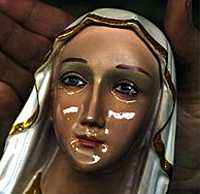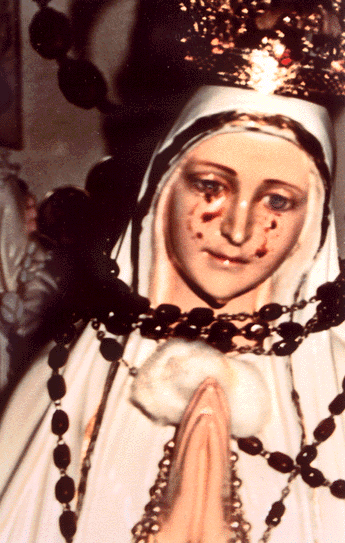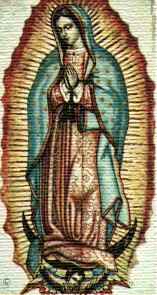|
Weeping Statues It's probably the poetical literacy of the image which has made the weeping statue such an enduring sort of miracle, the evocation of a sorrow so poignant that it moves even the cold stone of a statue to tears. Either that, or an early childhood trauma related to inappropriate imprinting of an inanimate object. Whatever. The point is, it's potent.
It's probably the poetical literacy of the image which has made the weeping statue such an enduring sort of miracle, the evocation of a sorrow so poignant that it moves even the cold stone of a statue to tears. Either that, or an early childhood trauma related to inappropriate imprinting of an inanimate object. Whatever. The point is, it's potent.
Ever since Moses drew water from a rock in the desert, the idea of the weeping statue has held a strange fascination for million of religious devotees. The most frequently reported "weeping statue" sighting is a Roman Catholic trip involving the Virgin Mary. Although there have historically been weeping and bleeding statues from virtually every denomination (such as weeping Buddhas, milk-drinking Ganeshes, and even a weeping Elvis statue), the Virgin Mary seems to have a special hold on the spiritual visions of the 20th Century.
Thus, it comes as no surprise that there are somewhere between dozens and hundreds of reports of Virgin Mary statues seen weeping over the last 80 years or so. The surge in Mary's paranormal activity has been most evident over the last 200 years, and especially since the 1858 apparition at Lourdes, France, which most observers consider the official start date of the Virgin Mary's World Tour. Not every venue is big enough to get a full-scale apparition from Mary, but no outlet is too small to have a weeping statue. Most reports of weeping statues come from small communities and locations not otherwise renowned for their Christian sanctity—Las Vegas, Bangladesh, Trinidad, Kansas. Statues are seen to weep, sometimes shedding tears of blood, in a dramatic display. Unlike many paranormal events, these incidents are remarkably well-documented and the statues often become tourist-pilgrimage attractions. There's also a bit of a domino effect in many such reports, in which additional statues in the vicinity are also moved to tears.
Lake Ridge is a government town, full of reasonably credible witnesses. When a statue of Mary belonging to a local priest began weeping in his family's home, it quickly spread to other statues in the house. Conventional examinations failed to explain the phenomenon, and the freakiness of the situation was exacerbated when the priest developed stigmata. The weeping spread like a plague, until a large public statue let the cat out of the bag by weeping on the church lawn. A test showed that the tears were not human tears, but simple water. No other investigation yielded any particular insight into what was going on.
There are dozens of ways to fake a weeping statue, ranging from chemical treatments to tubes and pumps. In fact, it's one of the simplest illusions to fake, as easy as smearing cold Crisco on the statue's eyes. But even though there are a million ways to fake it, as the skeptics will gleefully gloat, there aren't any examples of anyone actually getting caught doing it, a fact that the skeptics will shamefacedly attempt to obfuscate or even deny in a flat-out lie. In fact, despite a reasonably thorough search by Rotten.com, the only major verifiable examples of people faking weeping statues appear to be the skeptics themselves, in their eagerness to prove how easy it would be for someone else to do it. In a handful of cases over the last 20 years or so, scientists have tackled weeping statues in an effort to debunk them. Although they've been able to provide "reasonable" explanations in some cases (such as a natural condensation of water around the eye shapes or microscopic cracks in the material of the statue), these effects appear to have occured naturally. So they're not exactly supernatural, but they don't seem to be "fake" in the sense of people actively trying to deceive other people. It might have happened some time, but the high profile incidents appear to be innocent, whether or not they're supernatural.
What no one has yet demonstrated—in Lake Ridge, or anywhere else—is a convincing motive for faking the effect. While the weeping statues are usually connected to a location or family, there have been virtually no examples of anyone trying to meaningfully exploit the phenomenon for profit or even for evangelism. It's possible that some people might just want attention, even if that attention is strictly of the "Eyewitness News" variety, but the weeping statues aren't tied to any particular theological message (unlike Marian apparitions which tend to deliver fairly specific messages like "the world is ending" or "go see Mel Gibson's movie"). In the end, as with most matters related to religion or quantum physics, the burden of choice falls to the person observing the phenomenon. As litmus tests of faith go, the weeping statue is almost perfect. It's just weird enough to make you wonder, but just explainable enough to make you doubt. On the cusp of credulity, your natural inclination is the difference-maker that tips the scales. What do you want to believe today?
|
 By all accounts, Mary is very sad. After all, she had to watch
By all accounts, Mary is very sad. After all, she had to watch  Perhaps the most spectacular "weeping statue outbreak" was a 1991 incident in Lake Ridge, Virginia, attracted national attention and prompted a massive effort by mainstream media to find something definitive and not stupid-sounding to say about the issue. (US News and World Report alone devoted 4,000 words to the story in a single 1993 issue, the sort of coverage usually reserved for a nuclear war in progress.)
Perhaps the most spectacular "weeping statue outbreak" was a 1991 incident in Lake Ridge, Virginia, attracted national attention and prompted a massive effort by mainstream media to find something definitive and not stupid-sounding to say about the issue. (US News and World Report alone devoted 4,000 words to the story in a single 1993 issue, the sort of coverage usually reserved for a nuclear war in progress.) After a rash of healings and visits from hundreds of pilgrims, the weeping gradually died down, as did the stigmata, as did the public's interest.
After a rash of healings and visits from hundreds of pilgrims, the weeping gradually died down, as did the stigmata, as did the public's interest.  There's a thorny theological question that emerges from these "natural" explanations: If God works in mysterious ways, presumably he or she might choose to spontaneously cause a phenomenon that also happens to be natural. And technically, if you believe in God at all, then anything he or she causes to happen is natural by definition.
There's a thorny theological question that emerges from these "natural" explanations: If God works in mysterious ways, presumably he or she might choose to spontaneously cause a phenomenon that also happens to be natural. And technically, if you believe in God at all, then anything he or she causes to happen is natural by definition.